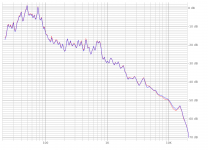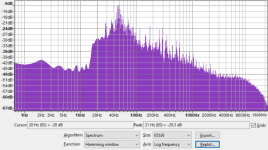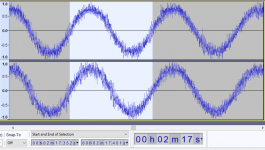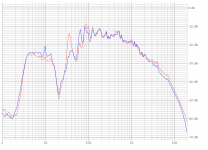LORDSANSUI - I write my own software as a hobby. I am surprised there are not more hobbyist programmers on this site.
Nice and very challenging. I like to program too, but more using MatLAB. I made scripts for specific tasks.
One think that I like to do is to evaluate multi channel signal analysis, from electric instead point, like if I apply a Low Pass Filter at 100Hz, what will be the peak voltage signal sent to the amplifier? and if and move this filter to 200Hz how much voltage the signal will increase. One day I may find an easy way to optimize a multi-way system fronm electrical point of view (the acoustic crossover different history witch needs to be combined later) . First I also need to make a database myself checking signal amplitude for each frequency based on music style (recorded ones).
That is easy to do by looking at the spectrum. One thing that I have learned is how recordings are manipulated. I can spot a spectrum that is not natural acoustic sound. 😉
Ed
Ed
Sorry. bah humbug.Just watched the new Top Gun Maverick film. Here's my RTA graph from the movie:
Plenty of sub bass through the whole film with the jets and engines. Lots of 40hz peak stuff with the explosions, machines, slams, etc. I was getting lots of tactile response from 18~20hz range pretty often with the jet engines in almost every other scene or so, so
Very best,
You want to experience jet engines? Stand at the parking lot while an F22 flies overhead.... or stand at the flight line and watch a B1B fly by at 400 mph 200 feet off the deck, then hit the afterburners and climb to 40K feet.... about a 1/16th of a mile from where you're all standing watching the show.
(Note, not an "air show", those people do that as a matter of daily routine... ).
I suggest Edwards AFB... nowhere else are they allowed to do that...
THAT IS LOUD.
And no amplifier, subwoofer is gonna EVER give you that kick in the solar plexus and do your ear drums ( that's why you are expected to wear ear plugs... ).
No so bad.. how about a car race with those engines ripping at WOT... not as loud as a jet, but again, were those ear plugs.
Ed,Chris - Here is the spectrum of a somewhat more recent rock recording - Metallica's "Enter Sandman".
This one also rolls off very quickly below 40Hz. "Enter Sandman" has a lot of high-frequency energy (enough to drive listeners from the room if played loudly). 😉
I am not saying that low bass should be rolled-off, just that it has been in all of pop/rock recordings that I have analyzed.
Ed
Try this one: Limit To Your Love by James Blake. It's not my favourite song particularly, but is a good showcase of what modern recordings can contain.
Chris
Ed,
Try this one: Limit To Your Love by James Blake. It's not my favourite song particularly, but is a good showcase of what modern recordings can contain.
Chris
I just listened to that... that low synth bass is gratuitous... IMHO it has no correlation to the music. It sounds like an extremely boring (ie: sinusoidal) tone, not much complexity to it except for a low frequency pulse train.
Metallica, OTOH, is putting out a performance that makes sense musically. Although, we (wife too) prefer The Unforgiven.
I've been playing this is my office stereo... very accurate set up but not loud. Tomorrow I'll crank the 2ch in the living. I'll bet those Metallica tom toms are gonna shine. There is a "richness" to the sounds of the instruments.
Last edited:
The pedal low C on a church organ with a 32' stop (quite common in large churches) has a fundamental of half of the contra-bass, i.e. 16.4 Hz. Now not all of the organs use real 32 feet pipes on the lowest notes (mostly due to physical difficulty of housing such long pipes). Some of them use a mix of two shorter pipes on the lowest notes to "simulate" the fundamental, but you will hear the fundamental, albeit a bit softer. Now there are at least two organs in the world with 64' pipes (according to Wikipedia). They would go down to 8 Hz. I can't imagine how they sound. If you look at a spectrum analysis of some organ music also from Youtube, you can see that music actually contain notes below 20 Hz. Just an example: In this recording, at 0:58sThe low E on a contra-bass (bass viol, string bass) or electric bass has fundamental of 41.2 Hz.
The low C on a contra-bass with low C extension has fundamental of 32.7 Hz.
The low B on a five string electric bass has fundamental of 30.9 Hz.
The very lowest notes in a church organ can get way down there. But can any microphones faithfully capture a 10 Hz fundamental?
I don't think people 'hear' 20 Hz. It's more like you can feel it. Of course, so can your neighbors. Such low frequencies roll like thunder. Actually, exactly like thunder. Or earthquakes. You need to simulate an earthquake?
Here's my first attempt - very crude, not really seeking to prove anything other than satisfying my own curiousity.If I ever had the time...
Mainly using music that I've previously purchased on Bandcamp, downloading the .wav files and dropping them in Audacity.
Any feedback on the method used is welcome:
Author & Punisher - Incinerator
Peaks under 50Hz are: 47hz -14.3db, 39hz -14.0db, 29hz -23.4db and 25hz is -42db
Puscha - Aboreality
Peak at 53hz is -26.6, 30hz is -47.1 and 27hz is -52.5
Alec Empire - Bass Terror (tbh I didn't expect much bass from this rough 1993 recording)
39hz is -21.4, 31hz is -35.6, 23hz is -40
John McGuire - 108 Pulses (1975)
Peak at 65hz is -27.6, 33hz is -56.1 and 25hz is -59.8
and finally some "popular" (relatively) music... no real criteria for choosing these
Meshuggah - Broken Cog (purchased this single track only from qobuz)
44hz is -21.9, 31hz is -34.6 and 25hz is -45
Skream - Make Me (purchased from Beatport)
44hz is -8.2, 29hz is -30.5 and 19 hz is -37.2
so yeah, that was one way to spend a few hours of time late on a Tuesday night...
I have a few more tracks in mind, and some more bandcamp purchases to make too. Will share more if/when I get around to it.
Here it is from Youtube.Try this one: Limit To Your Love by James Blake.
"Limit to Your Love" does have low bass. It also does not have tipped-up treble. This is a very listenable recording (but I too don't care for the musical style).
bitSmasher - I see that you too are having fun with FFTs.
A natural spectrum peaks in the mid-bass and monotonically goes down in amplitude above that. When you see flatness in the upper midrange and low treble, it is a sign of an ear-bleeder.
Ed
Attachments
bitSmasher - I am too old to know about popular music after 1991. 😉
Ed
That's when the record labels started investing in private prisons. Positive music gave way $3X, drugs, and guns to fill jail cells. And guess what, private prisons take t@x p@y3r $ when the 90\/3rnm3nt doesn't meet the record labels' occupancy quotas.
Here's my first attempt - very crude, not really seeking to prove anything other than satisfying my own curiousity.
Mainly using music that I've previously purchased on Bandcamp, downloading the .wav files and dropping them in Audacity.
Any feedback on the method used is welcome:
Author & Punisher - Incinerator
View attachment 1128501
Peaks under 50Hz are: 47hz -14.3db, 39hz -14.0db, 29hz -23.4db and 25hz is -42db
Would all that stuff under 20Hz be artifacts? Definitely it's not a real instrument but some kind of made up signal.
Some is HVAC.Would all that stuff under 20Hz be artifacts? Definitely it's not a real instrument but some kind of made up signal.
Ed
Since there have been a few spectra posted, I thought this might be interesting: The first screenshot is an FFT of the track Sugar Rush by PIXL. While it clearly has a lot of bass, the overall figure of -28dB @ 20Hz doesn't quite reflect what's going on... The second screenshot is in the time domain, showing that when it goes down to 20Hz, it's actually nearly full scale, if only for a short while.
There might not be a lot of music with content that low, but it exists, so I want to reproduce it.
There might not be a lot of music with content that low, but it exists, so I want to reproduce it.
Attachments
I noticed the same thing on orchestral music: the drums are struck only a few times, and so the level appears low when averaged over the entire piece. It is possible to run a FFT over just the portion with drums.
P.S. I debugged the slight misalignment of the X-axis in my graphs. The next graph will be perfectly aligned.
Ed
P.S. I debugged the slight misalignment of the X-axis in my graphs. The next graph will be perfectly aligned.
Ed
Not too sure on how all diy speaker builds exactly function, be it crossover and what not, but isn't like 8 hz self deficating at a certain decibel. Just get headphones and add some power and complete the circuit. And ask him if you want him to finish it before it melts and in between several blasts. Jk, unless you guys like to joke here and there. Lol
I noticed the same thing on orchestral music: the drums are struck only a few times, and so the level appears low when averaged over the entire piece. It is possible to run a FFT over just the portion with drums.
P.S. I debugged the slight misalignment of the X-axis in my graphs. The next graph will be perfectly aligned.
Ed
A peak-hold option would be useful. REW has that, but that requires playing the tracks in real-time to analyse them.
Also, any chance you could extend your LF cutoff to 10Hz or below?
Cheers,
Chris
That's a really good point, in my initial playing around I found that what REW was showing (as a peak level) was a vastly different curve to Audacity's averaging.
When I revisit this, I'll put time aside to run the same tracks through REW since I'm very curious about those intermittent busts of bass
When I revisit this, I'll put time aside to run the same tracks through REW since I'm very curious about those intermittent busts of bass
I did not do peak-hold because it would violate conservation of energy.A peak-hold option would be useful. REW has that, but that requires playing the tracks in real-time to analyse them.
Also, any chance you could extend your LF cutoff to 10Hz or below?
My program computes one big FFT (4-8 million points) and does filtering in the frequency domain. It can analyze down to 0.01Hz. 😉
Ed
I found something unusual. This is the "Battlestar Galactica" theme by John Williams and the Boston Pops from the "Out of This World" CD. This piece is heavy on percussion and brass.
I analyzed down to 1Hz. There is a lot of infrasonic energy. There is also a steep notch at 20Hz. This looks like an attempt to notch out deep bass, but the digital recorder could capture below 20Hz.
Ed
I analyzed down to 1Hz. There is a lot of infrasonic energy. There is also a steep notch at 20Hz. This looks like an attempt to notch out deep bass, but the digital recorder could capture below 20Hz.
Ed
Attachments
You guys need to check out the BEQ thread on avsforum.com.
https://www.avsforum.com/threads/bass-eq-for-filtered-movies.2995212/
https://www.avsforum.com/threads/bass-eq-for-filtered-movies.2995212/
- Home
- Loudspeakers
- Subwoofers
- 10-25 Hz, is it necessary for HT or Music?



